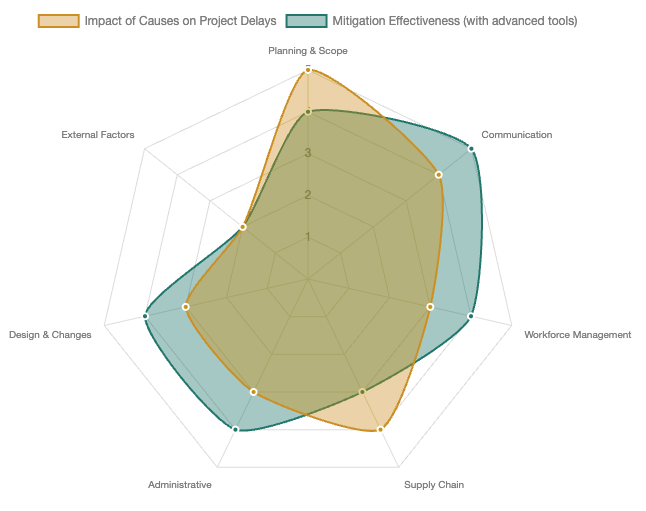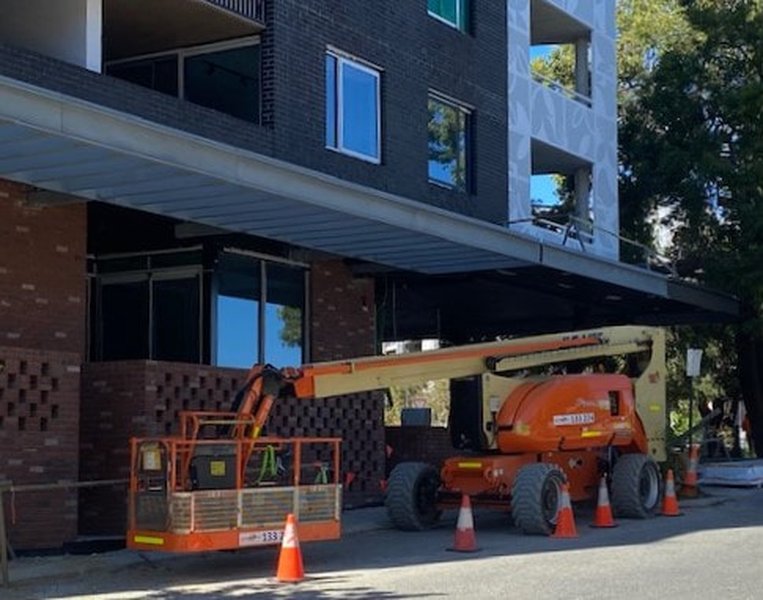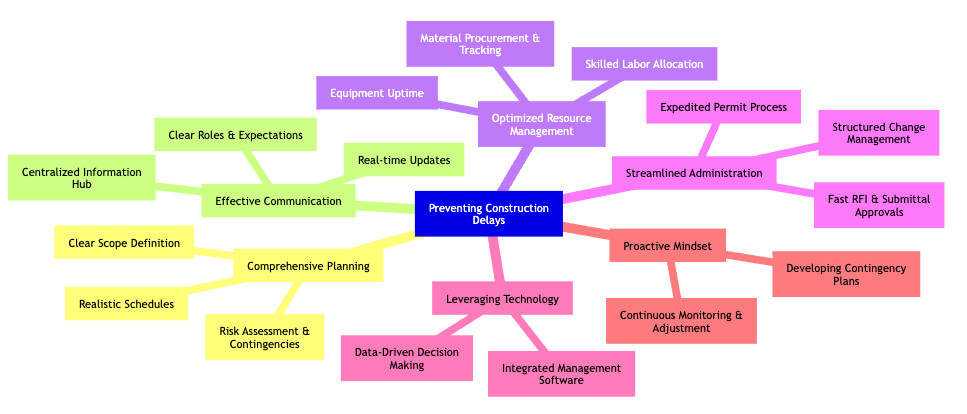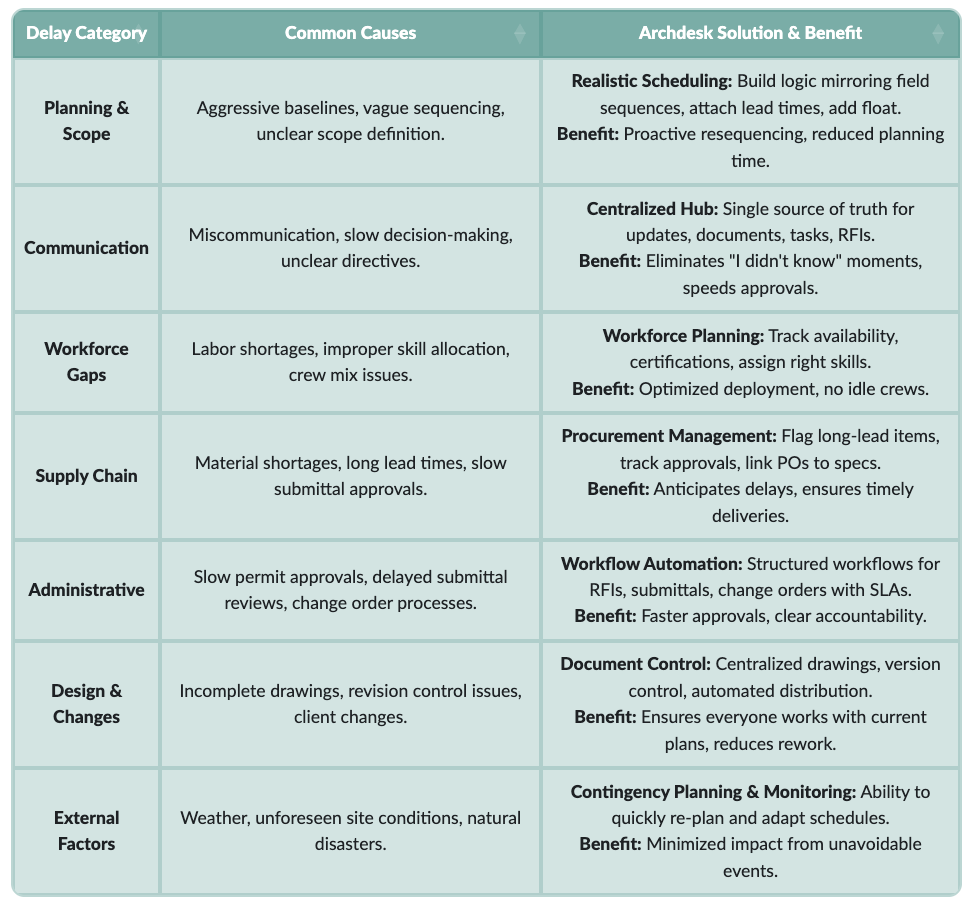Key Insights into Delay Prevention
- Communication is paramount: A breakdown in communication often leads to a cascade of costly errors and idle hands.
- Planning isn't just a step, it's a foundation: Underestimating risks and skipping detailed pre-construction planning sets the stage for future headaches.
- Technology is your co-pilot: Integrated platforms offer real-time insights, helping you anticipate and mitigate issues before they escalate.
You know that feeling. The schedule was tight, but everyone agreed it was doable. Then, out of nowhere, things start to fray. A material delivery goes missing. A permit gets stuck in bureaucratic limbo. Suddenly, that finish line you were eyeing starts to recede, becoming a moving target. It’s frustrating, expensive, and honestly, it just feels like part of the construction game, doesn't it?
But what if it didn’t have to be? What if you could anticipate those snags and tackle them head-on, keeping your projects on track and your team smiling?

Understanding common pitfalls is the first step to avoiding project delays.
The Usual Suspects: Why Projects Hit the Skids
When a project stalls, it’s rarely one giant, sudden disaster. More often, it’s a series of smaller, seemingly minor issues that, when left unchecked, snowball into major delays. Let’s talk about the real culprits.
Poor Planning and Communication Breakdown
When Blueprints Get Blurry
Honestly, so many delays can be traced back to this. If your initial project scope isn't crystal clear, or if the designs feel more like a rough sketch than a detailed plan, you're practically inviting trouble. It’s like trying to bake a cake without knowing the ingredients or the oven temperature. Often, folks underestimate costs or misjudge risks right at the start. This can lead to projects sputtering out because of budget shortfalls or forced scaling back.
Detailed pre-construction planning, working hand-in-hand with architects and designers, makes a world of difference. It's about building contingency into your schedule, not just hoping for the best-case scenario. What if the concrete truck is a day late? What if an inspector needs more information? Planning for these "what-ifs" isn't a sign of weakness; it’s just good business sense.
The Game of Telephone Effect
Remember playing "telephone" as a kid? By the time the message got to the last person, it was completely garbled. That’s exactly what happens on a construction site when communication goes sideways. A lack of clear, consistent dialogue between teams, subcontractors, and even clients is a top offender. If everyone isn't on the same page about roles, timelines, and who depends on whom, things can go awry fast. Imagine a client changing their mind about a fixture, but the message doesn't reach the site manager until the wrong items are already purchased and installed. Talk about a costly oversight!
Prioritizing communication above all else means moving past scattered emails, phone calls, and paper trails. You need a single source of truth where everyone—from the project owner to the site manager—can see real-time updates, document changes, and assigned tasks. Transparency helps prevent those expensive "I didn’t know" moments.
Workforce Woes and Material Mayhem
Finding the Right Hands
Finding skilled labor? That's a huge challenge, isn't it? The construction industry, particularly in places like North America, is grappling with a significant labor shortage. An aging workforce, people moving on, and difficulties bringing in new talent mean many crews are short-staffed. This doesn’t just slow things down; it can affect quality and even safety. Deploying the right people to the right projects, based on their skills and experience, is absolutely crucial. You can have all the materials ready, but if you don’t have the skilled hands to install them, everything grinds to a halt.
Supply Chain Snags
Supply chain issues. We've all been talking about them, and they aren't going away anytime soon. Shortages of steel, lumber, HVAC equipment – you name it. When materials don’t show up on time, crews stand idle, and the entire project grinds to a halt. It’s a domino effect that can add months to a schedule. Keeping tabs on supplier performance and anticipating potential delays can really help you get ahead of this. For example, in Europe, public approvals can add weeks, while in the GCC, heat and Ramadan scheduling require early labor planning.
Administrative Roadblocks and Design Dilemmas
The Permit Predicament
Ah, the paperwork. Administrative delays, like slow permit approvals or drawn-out submittal reviews, impact a significant portion of projects. These hold-ups can add months to timelines, as some studies from 2025 have noted. It’s not just an inconvenience; it's a major schedule killer. Some firms have found ways to cut planning time significantly by improving how they handle these processes.
When Plans Change Mid-Stream
Sometimes, the plans themselves are the problem. Inaccurate or incomplete design documents can lead to time-consuming adjustments and rework. And then there are change orders. Clients often have new ideas once a project is underway. While these changes might improve the final product, they almost always introduce delays and additional costs if not managed carefully. Having a clear process for handling these changes and communicating their impact is essential.
External Factors and Unexpected Events
Mother Nature's Curveballs
Some things are just beyond our control, right? Think about severe weather – a sudden blizzard, a torrential downpour, or extreme heat. These can stop outdoor work dead in its tracks. Natural disasters or unforeseen site conditions also fall into this category. While you can't prevent Mother Nature from doing her thing, you can certainly plan for these "excusable delays" by building contingencies into your schedule and budget. For North America, planning around heat waves and freeze windows is critical; for Europe, wet seasons require concrete and facade flexibility.

This radar chart illustrates the perceived impact of various delay causes on construction projects versus the potential effectiveness of mitigation strategies, particularly when leveraging advanced tools. As you can see, robust planning and improved communication offer the greatest gains.
The Ripple Effect: What Delays Really Cost
The fallout from delays? It’s more than just a minor headache. Financially, cost overruns can balloon into thousands, sometimes forcing companies to absorb losses. Legally, you risk disputes or penalties if contracts aren't met. Emotionally, it wears on your team – morale dips when folks feel stuck. I've heard CEOs in Europe lament how one delayed project can ripple into others, straining client relationships. In competitive markets like the GCC, where timelines are tight, a single slip can tarnish your reputation. Why let that happen when prevention is within reach?

Project delays aren't just about time; they impact budgets, morale, and reputation.
Steering Around the Snags: Strategies That Actually Work
So, how do we navigate this minefield of potential delays? The secret sauce lies in effective project management, meticulous planning, and clear communication. It’s about having the right tools to give you visibility and control. And honestly, it’s not about working harder, but working smarter.
Build a Realistic Blueprint
Start with solid planning. Create a schedule that truly reflects how the job gets built, not just an optimistic timeline. Build in a little buffer – some float – for critical trades. Lock in long-lead procurement milestones early. What if you know there’s a wet season coming in Europe? Plan for it. Shift pours, use night shifts, or even tents. Anticipate risks like weather or supply issues by building those buffers into your schedule. Don’t just plan for the ideal; plan for reality.
Mastering the Flow of Information
Communicate openly, constantly. Make sure every subcontractor knows their role and their dependencies. Tools help here; regular check-ins keep everyone aligned. Move beyond scattered notes and emails to a centralized system where everyone can access the latest information. This helps speed up approvals, clarifies responsibilities, and minimizes miscommunication.
Intelligent Resource Deployment
For labor, track skills and availability well in advance to avoid shortages. It's not just about having bodies on site; it's about having the right foreman on the right job, with the right certifications. And for materials, order smarter. Approve submittals early, place combined purchase orders, and set "ship-complete" rules to avoid partial deliveries that kill productivity. Prefabrication, where possible, can even help weather punish the schedule less.
Embracing Technology: Your Project's GPS
This is where the right tools truly make a difference. Relying on spreadsheets and manual tracking for something as complex as a construction project is like using a paper map on a cross-country road trip. You might eventually get there, but you’ll hit every dead end along the way. Instead of juggling a dozen different systems, imagine one comprehensive platform that brings everything together.

This mindmap illustrates a holistic approach to preventing construction delays, highlighting interconnected areas where strategic focus can yield significant improvements.
Archdesk: The Navigator for Your Construction Journey
This is where a comprehensive platform like Archdesk truly shines. Unlike a collection of disparate tools that might handle just one aspect, Archdesk pulls everything together. It helps you track projects from conception to completion, giving you a broad, detailed view of every moving part. You know, some of the other players out there, like Procore or Autodesk Construction Cloud, are pretty robust, but Archdesk feels tailored, especially for mid-sized and large outfits, integrating everything without overwhelming your team. It’s like having a GPS for your entire operation.
With Archdesk, you can:
Scheduling with Reality Baked In
Create task logic that actually mirrors field sequences, attach lead times to activities, and add float without breaking critical paths. If a supplier slips a week, Archdesk can ripple that impact across dependencies, allowing you to resequence in minutes. It helps you build realistic schedules, account for potential contingencies, and track progress in real-time. If a delay pops up, Archdesk can help you quickly generate corrective schedules, making it easier to adapt and minimize impact.
Procurement That Beats Lead Times
Link specs and submittals directly to purchase orders. Archdesk flags long-lead items early, tracks approvals, and sets ship dates against milestones. No more "did it ship?" phone tag. It helps you keep tabs on every expense, manage procurement, and monitor your budget closely. This real-time financial oversight means fewer surprises and a better handle on profitability.
Drawing and Document Control
All your drawings, contracts, and other critical documents are in one secure, cloud-based system. Archdesk ensures everyone is working with the latest versions, cutting down on errors and reworks. Superintendents and subs always see the current set on their mobile devices. Less rework, fewer "wrong rev" installs.
Cost and Cash Visibility
Get real-time cost-to-complete and committed costs, so you can spot funding gaps before they hit the site. Tie pay applications and variations to schedule impact, not guesswork. This means you understand your project’s financial health intimately.
RFI and Change Order Speed
Structured workflows with service level agreements, reviewer assignments, and audit trails mean you'll know what’s stuck, who’s holding it up, and for how many days. It prevents minor changes from turning into major headaches.
Workforce and Resource Planning
See crew availability across jobs, assign the right skills to critical activities, and avoid that dreaded "everyone’s on another site" stall. Archdesk helps you assign the right people to the right jobs, track their availability, and ensure your teams are working efficiently. No more idle crews because of scheduling mix-ups!
Field Progress That Tells the Truth
Daily diaries with photos, percent complete, and production tracking feed back into schedule health. You can pivot midweek, not next month. This granular visibility helps you make informed decisions quickly.
This bar chart represents the potential impact of leveraging a comprehensive platform like Archdesk across various aspects of construction project management, leading to significant delay reduction and improved efficiency.
A Practical Cadence for Success
A simple, consistent rhythm can keep things humming. For example, Monday mornings should be about looking ahead two weeks: confirming materials, crews, access, and inspections. Midweek, tackle those RFIs and submittals – anything older than five days gets escalated. And by Friday, update progress, costs, and risks, locking in next week’s handoffs, not just tasks.
You know what? Delays will still try to sneak in. That's just the nature of construction. But the difference is whether they stack up, becoming insurmountable mountains. Archdesk gives you one clear line from decision to delivery, so a late door or a rainy Tuesday doesn’t balloon into a missed quarter. If you want fewer surprises and calmer handovers, start with long-leads, drawing control, and RFIs inside Archdesk. Get those three right, and your schedule starts breathing again.

FAQ: Your Burning Questions Answered
What are the most common reasons for construction project delays?
The most common reasons often include poor planning and scope definition, breakdowns in communication, labor shortages, supply chain issues, administrative bottlenecks like permit delays, and unforeseen external factors like severe weather. It's often a combination of these that creates significant problems.
How can better communication prevent delays?
Better communication ensures everyone involved—from the project owner to the onsite crew—is on the same page. A centralized platform that provides real-time updates, clear task assignments, and streamlined document sharing minimizes misunderstandings and speeds up decision-making, preventing costly errors and idle time.
Is it possible to completely avoid all construction delays?
Completely avoiding all delays is challenging due to the inherent complexities and external variables in construction. However, by implementing robust planning, fostering clear communication, and leveraging integrated construction management software, you can significantly reduce the frequency, duration, and impact of delays, making projects much more predictable.
How does technology like Archdesk help mitigate delays?
Archdesk acts as a central nervous system for your project. It helps by providing tools for realistic scheduling with built-in contingencies, real-time procurement tracking, centralized document control, streamlined RFI and change order workflows, and intelligent workforce allocation. This integrated approach gives you real-time visibility and control, allowing you to anticipate and address issues before they escalate.
Conclusion: Building a Smoother Path Forward
Delays might seem inevitable in construction, but they’re not unbreakable. By tackling the root causes head-on with better planning, relentless communication, and powerful tools like Archdesk, you can deliver on time more often. It’s about being prepared, not just reactive. Think about how technology fits into your setup – it might just smooth out those rough edges and keep your projects not just moving, but thriving.
References
Platform vs. Point Solutions in Construction Software | Archdesk Blog
Construction delay - Wikipedia
9 Reasons to Buy Construction Management Software | Archdesk Blog
24 Tips to Prevent Construction Project Delays
r/Construction on Reddit: What are the main reasons you experience delays in construction projects?





